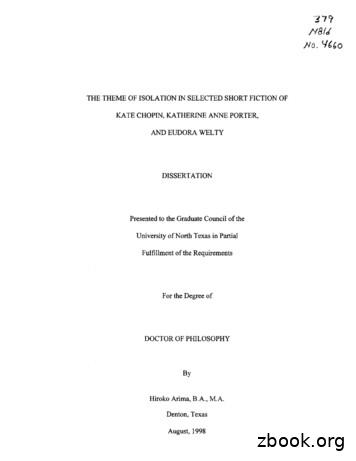Isolation And Purification Of Proteins
Isolation and Purification of ProteinsDr. Aws AlshamsanDepartment of PharmaceuticsOffice: AA87Tel: 4677363aalshamsan@ksu.edu.sa
Objectives of this LectureBy the end of this lecture you will be able to:1. Describe most common methods of proteinisolation and purification2. Compare between different methods ofprotein purification3. Construct a purification algorithm based onyour knowledge in protein purification
Intracellular and Extracellular
Intracellular and Extracellular
Isolation of Extracellular Proteins No need for cell disruption Secreted soluble proteins can be collected inthe cell supernatant after centrifugation Membrane-bound proteins might be releasedfrom the cell simply using detergents
Isolation of Intracellular Proteins Needs cell disruption:– Detergents lysis– Enzymatic lysis– Osmotic lysis– Freeze-thaw cycles– Ultrasonication– Homogenization
Isolation of Intracellular Proteins
Purification of Proteins Differential centrifugationDifferential salt precipitationDifferential solvent precipitationPreparative electrophoresisColumn chromatographyMore than one approachmay be required
DifferentialCentrifugation
Differential Centrifugation Separation of proteins (or any material) onthe basis of their size, mass, and density It is a function of the size of the protein andthe speed if centrifugation It is gives us a rough separation. It is basicallyfractioning!
Dialysis
Dialysis Based on osmotic pressure It allows you to get rid of most salt ions It is impossible to remove the salts completely– Why?
Column Chromatography Most common and best approach to purifyinglarger amounts of proteins Achieves Highest level of purity and largestamount Requires low effort Lowest likelihood to damage the proteinproduct Standard method for pharmaceutical industry
Gel FiltrationIon ExchangeAffinity
Gel-Filtration Chromatography AKA Size-Exclusion (or molecularexclusion) Chromatography Molecules are separated according todifferences in their size as they passthrough a hydrophilic polymer Polymer beads composed of cross-linkeddextran (dextrose) which is highly anduniformly porous (like Swiss cheese) Large proteins come out first (can’t fit inpores), small proteins come out last (getstuck in the pores)
Gel-FiltrationChromatographyYou need to have a way to knowwhere your protein is:1. Molecular weight marker2. Add a target to your protein e.g.if you want to purify an enzymeadd a substrate to the tubesand see where does it appear
Ion-Exchange Chromatography Principle is to separate on basisof charge “adsorption” Highest resolving power Highest loading capacity Widespread applicability Most frequentchromatographic technique forprotein purificationThis column represents cationexchange chromatography
Ion-ExchangeChromatographyThe ion exchange processis based on concentrationof the counter ionThis column represents anionexchange chromatography
Affinity Chromatography Adsorptive separation in which the molecule to be purified specificallyand reversibly binds (adsorbs) to a complementary binding substance(a ligand) immobilized on an insoluble support (a matrix or resin) Purification is 1000X or better from a single step (highest of allmethods) Preferred method if possible
AffinityChromatographyHow can I get my protein outof the column?The protein is not covalentlybound to the ligand
Isoelectric Focusing
Polyacrylamide Gel ElectrophoresisElectrophoresis separates proteins based on their size using electricalcurrent
Polyacrylamide Gel ElectrophoresisLargestSmallest
Preparative electrophoresis2D Polyacrylamide Gel Electrophoresis (2D PAGE)Step 1: Isoelectric Focusing (IEF)Step 2: SDS-PAGE
Molecular Weight (kDa)2-D PAGE
Now you are able to: Describe most common methods of proteinisolation and purification Compare between different methods ofprotein purification Construct a purification algorithm based onyour knowledge in protein purification
Affinity Chromatography Adsorptive separation in which the molecule to be purified specifically and reversibly binds (adsorbs) to a complementary binding substance (a ligand) immobilized on an insoluble support (a matrix or resin) Purification is 1000X or better from a single ste
innovation since the late 1970s. Our research scale purification instruments are the most technologically advanced and effective purification systems available. Our method development and purification algorithms help scientists convert traditional regular flash purification to faster, greener, and more economical processes for reliably isolating
individual purification methods based solely on their purification factor. Context is paramount. It is impossible to predict what combination of separation methods will work best for a given virus purification process, and how many steps will be required to achieve the degree of purification required to support a particular application. Development
Apr 11, 2017 · Chapter 13 –Moving Proteins into Membranes and Organelles 13.1 Targeting Proteins To and Across the ER Membrane 13.2 Insertion of Membrane Proteins into the ER 13.3 Protein Modifications, Folding, and Quality Control in the ER 13.4 Targeting of Proteins to Mitochondria and Chloroplasts 13.5 Targeting of Peroxisomal Proteins
purification strategy is one in which the highest level of purification is achieved in the fewest steps. The selection of best step to use is dependent on the size, charge, solubility and other properties of the target protein. [15] In most of the purification schemes described in literature, the protocol is generally a mix of non .
Magnetic beads for DNA purification 9 Genomic DNA purification kits 10 Genomic DNA extraction 16 Genotyping—pharmacogenomics studies 17 Plant genomic DNA isolation kits 18 Viral genomic DNA purification kits 20 Genomic DNA from saliva 21 Complete purification system for nucleic acids
PASSION AND ISOLATION 17 3. FAMILY AND ISOLATION 55 4. FEMININE INDEPENDENCE AND ISOLATION 77 5. SOCIAL ISSUES AND ISOLATION 130 6. CONCLUSION: ISOLATION AND WRITING AS RESISTANCE 167 . in his reworking of John Donne's "Meditation XVII" ("No man is an island ."), apply to the significance of creative writing. We can similarly compare .
Gate Driver Providing Galvanic isolation Series. Isolation voltage 2500Vrms. 1ch Gate Driver Providing Galvanic . Isolation BM6104FV-C. General Description. The BM6104FV-C is a gate driver with isolation voltage . 2500Vrms, I/O delay time of 150ns, and minimum input pulse width of 90ns, and incorporates the fault signal
2.4.2. Feeding strategy during fermentation 32 2.4.3. Induction strategy and effect of oxygen during fermentation 33 2.4.4. Scale up of fermentation process 35 2.5. Purification strategies for recombinant proteins 37 2.5.1. Recombinant protein as inclusion bodies 37 2.5.2. Inclusion body formation, isolation and solubilization 38 2.5.3.























